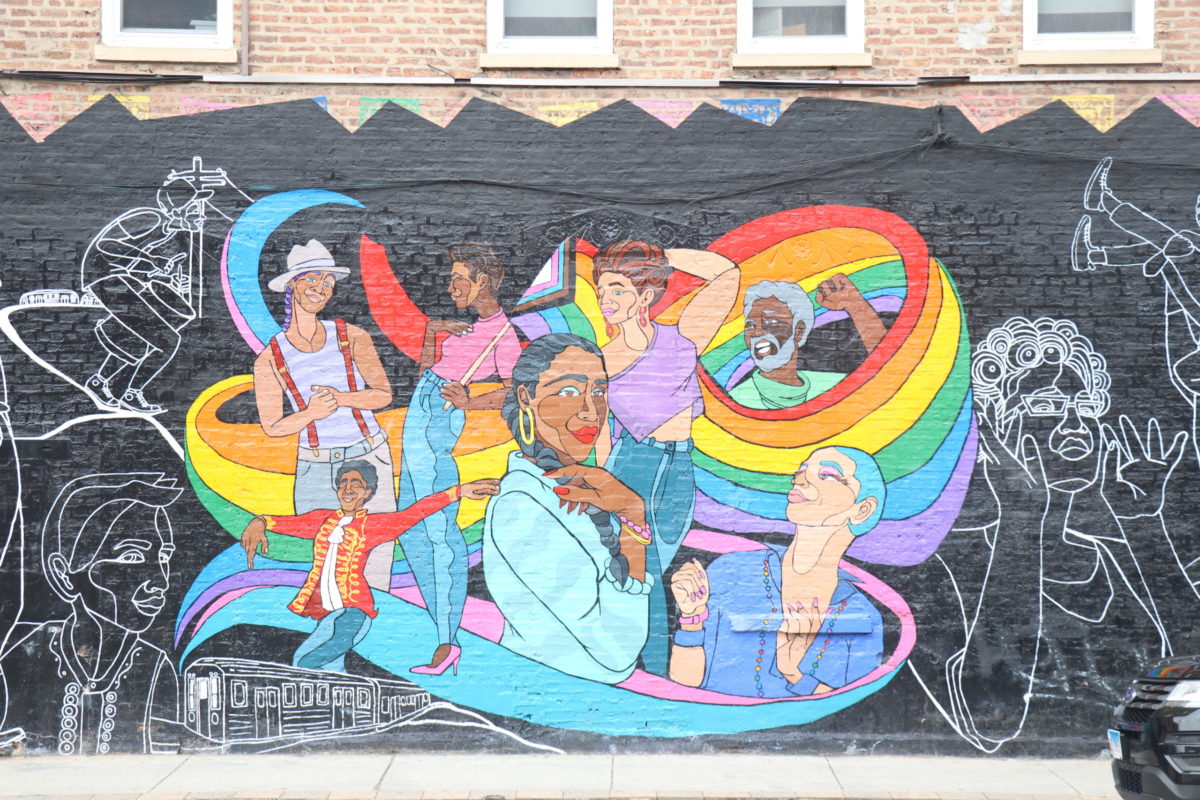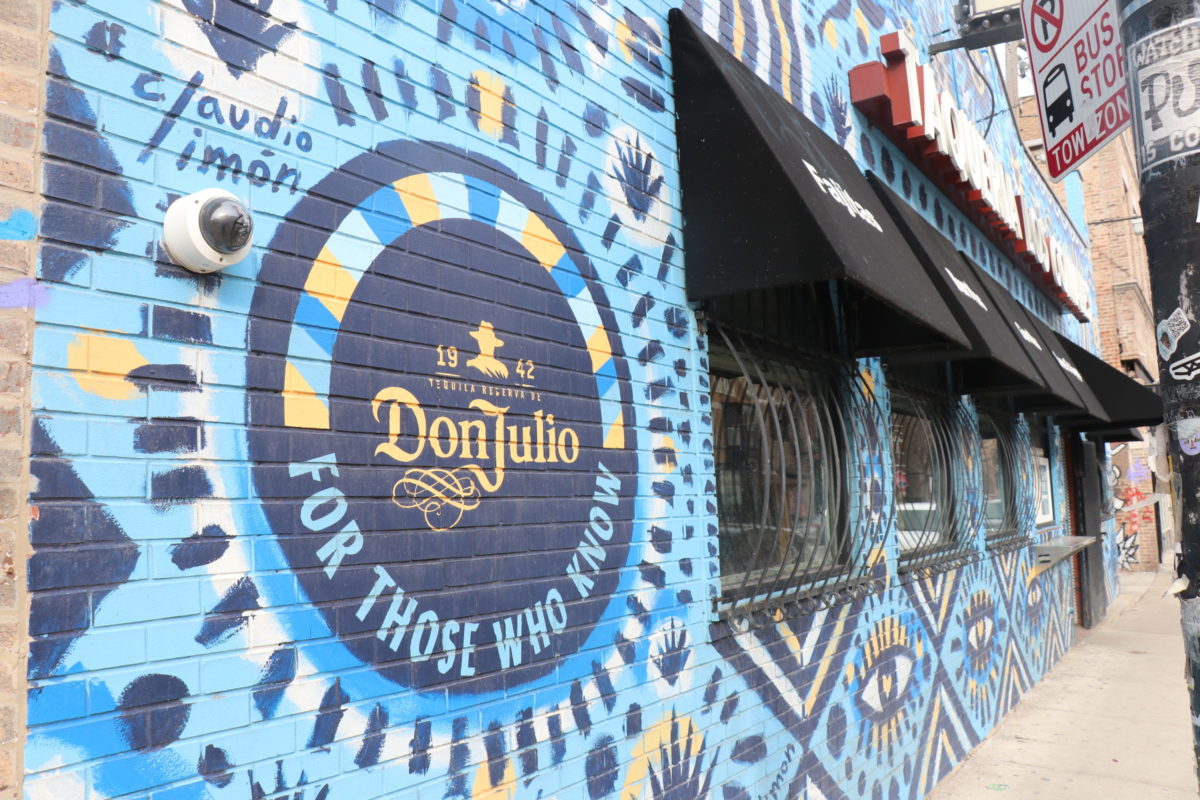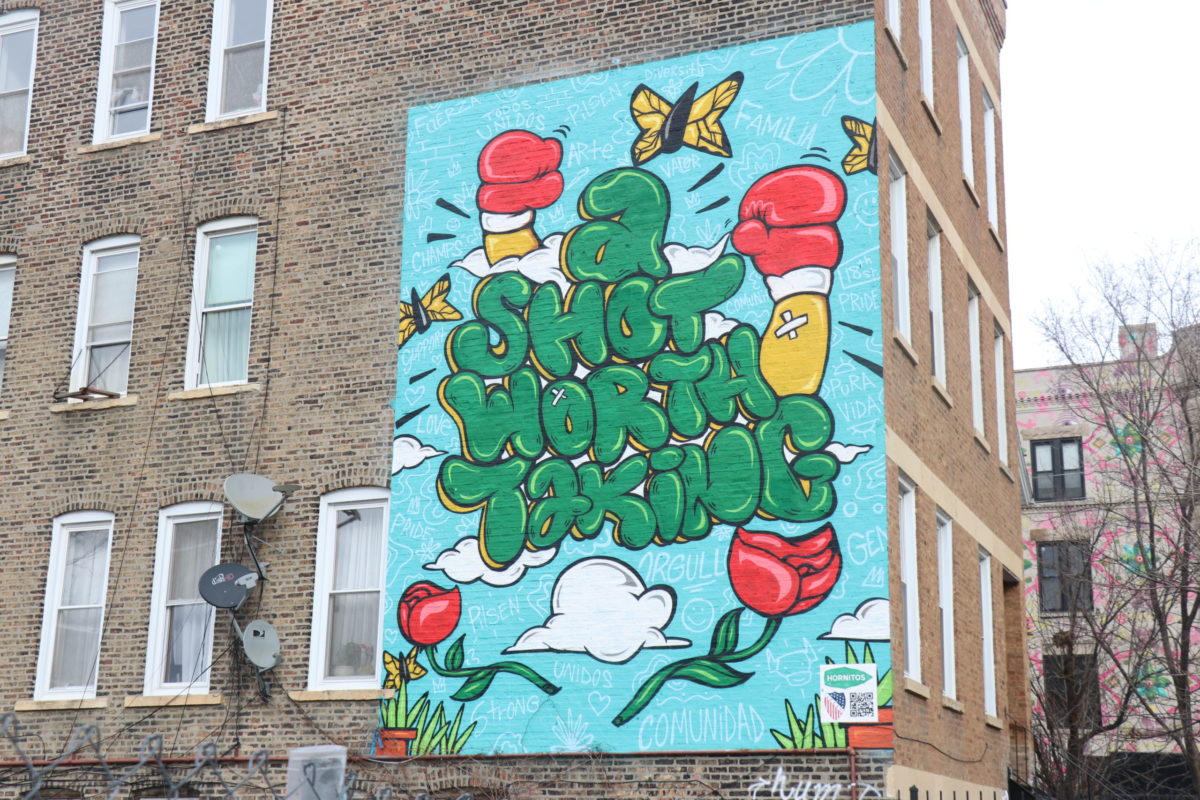The vibrant art that adorns the train stations, bridges, and building walls in Pilsen has increasingly become a neighborhood attraction on top of local bars and restaurants. Public art in Pilsen has a long history as a medium of political and social expression for residents, who have been predominantly Mexican since the 1960s or earlier. Mario Castillo, who painted Pilsen’s first Mexican mural “Peace” or “Metafisico” in 1968, said he created the anti-Vietnam war mural in an attempt to assert his Mexican identity. Over time, the practice of public art in the neighborhood has evolved to depict political struggles, youth initiatives, marginalized communities, and more. In recent years, the murals have included something different: alcohol brands.
A City ordinance passed in 2019 allows mural artists to recognize their business sponsors in their work and still have it be considered art, with recognition limited to an area of no more than two square feet adjoining the bottom of a mural, as a way to foster artists’ work that beautifies Chicago’s neighborhoods. Since then, at least three murals sponsored by liquor brands have emerged along 18th Street, Pilsen’s business district.

The storefront at Taqueria Los Comales exhibits bright blue and yellow patterns by Claudio Limón stamped with a Don Julio logo approximately four and a half feet in diameter. Crossing Ashland, “Fierce” by Sam Kirk spotlights a Black trans woman with other queer characters celebrating around a flowing rainbow in the background; a block on the top-right corner of the mural reads “Sponsored by Effen Vodka.” Further east on 18th Street, a mural collaboration between Hornitos Tequila and the League of United Latin American Citizens (LULAC) encouraging the community to get vaccinated against COVID-19 is displayed prominently on a side of the building.
Luis Tubens, the co-founder of Pilsen Public Art Tours, which does mural tours on foot, said that from the time Castillo painted Pilsen’s first Mexican mural, artistic styles have expanded in historical waves.
Following Castillo’s lead, the first wave of murals was overtly political and social in nature. The second wave came as graffiti, and despite objections from some artists trained in the first wave, graffiti art was considered a political act of resistance in itself. The most recent wave is what Tubens calls icon art, in which artists develop characters or staple icons that they replicate in various pieces.
“Fierce” fits into the expansion of what public art is and can be in Pilsen, according to Kirk, a Latina South Side native. She said the mural aims to bring visibility to the LGBTQ+ community in Pilsen, where she has heard and experienced homophobia.
“This piece—sponsorship aside—is very political,” she said. The mural was one installment of a collaboration with Effen Vodka that included workshops, and Kirk said she creates artwork that stays true to the community she is depicting. She picked the location herself, painting this mural in the same spot she previously displayed “Viva Fútbol,” a mural sponsored by Major League Soccer.
Kirk said Effen gave her creative liberty. “They just fully supported the work, which I was very grateful for,” she said. “There’s a lot of times where the brands are like, ‘Oh, it’s too much,’ you know, especially when showing self-expression for the LGBTQ community.”

Limón, a Mexican pop artist who worked with Don Julio Tequila on its “For Those Who Know” campaign, said in an email that the brand also did not influence his creative process. Rather, he said he was “inspired by Don Julio to create the murals and art pieces that tell the message Don Julio wanted to communicate.”
According to a representative from Hunter PR, the agency that managed the project on behalf of Don Julio, the project was intended to “highlight local family owned and operated eateries in a few cities that celebrate Mexican culture, and help tell their story through art.” Each mural was custom to the restaurant owners’ stories, the agency said. However, Don Julio–sponsored murals by Limón in Dallas and Brooklyn utilize similar color, patterns, and iconography.
The owners of Taqueria Los Comales could not be reached for comment.
The mural collaboration between Hornitos and LULAC uses the art, which plays on the Hornitos’ slogan “A shot worth taking,” to focus on their campaign mission. A QR code next to the organizations’ logos leads to COVID vaccination resources in Spanish. The artist used for this mural is not credited on the mural or in the media kit.
Tubens said, after a bit of deliberation, that he would rather see walls in Pilsen be covered with art that has a message, even if it is sponsored by a liquor brand, than to see them left blank. A factor in that preference is the potential for economic benefits that brand sponsorships bring to the neighborhood business, considering that there was a time in recent history when corporations didn’t recognize, pay, or market to the Latinx community.
“That’s a testament to the political power, but also to the financial buying power of the Latinx community, that now we’re finally being recognized not only by governments, but by corporations,” said Tubens.
Kirk said that working with brands not only helps her get paid for her work, but gives her the ability to give back to the community she is working within. For the “Viva Fútbol” painting, she was able to provide tuckpointing for the building, and for “Fierce,” she provided an anti-graffiti sealant on the mural and other parts of the building that were continuously getting tagged.
In its email response, Hunter PR said that it hosted a private celebratory dinner at the restaurant when the mural was complete.
Pilsen resident James Valadez shared Tubens’s sentiment recognizing the benefits of sponsorships, but also raised concerns regarding the type of brand sponsoring the murals.
“I live in a block with a school; I don’t love seeing art that has… alcohol, drugs, that kind of stuff near the school,” Valadez said.
3,966 children, who are largely Mexican-American, attend the ten public schools that are within a mile of one of these murals, according to Chicago Public Schools’ most recent enrollment data.
Unlike advertising for tobacco and other drugs, alcohol advertising is mostly unrestricted in regard to how and where it occurs. According to a study titled “The Alcohol Marketing Landscape: Alcohol Industry Size, Structure, Strategies, and Public Health Responses” published in the Journal of Studies on Alcohol and Drugs, alcohol brands are allowed to target certain communities, “including target marketing focused on special populations such as women, racial and ethnic minorities, young adults, older adults, adherents of particular sports, and so on.”
At least one mural on 18th Street is sponsored by a brand that is not a liquor company: the piece by Czr Pzr, at 1541 W. 18th Street, is supported by Ava Grey Designs. According to its website, Ava Grey is “a creative agency and production house comprised of artists and designers with a range of professional backgrounds, working towards a common goal of creating dynamic projects that connect to audiences in authentic and visually impactful ways.”
Since some of the murals in Pilsen are decades old, the sponsored murals that go up today could have a lasting impact.
“The issue is like the murals: they’re not black and white, they’re very colorful, and they’re full of complexity,” Tubens said.
Kinsey Crowley is a graduate student at the Medill School of Journalism specializing in social justice. She reports on local business and economic development news here in Chicago.


The logo is at least 12 sf, much, much larger than the allotted 2 sf. Is this going to be just another way of getting billboards accepted by the community?
Oops, meant the Don Julio logo.